NDVI stands for "Normalized Difference Vegetation Index". NRG stands for "Near-infrared / Red / Green". NDVI and NRG are both ways to visualize the amounts of infrared and other wavelengths of light reflected from vegetation. Because both these methods compare ratios of blue and red light absorbed versus green and IR light reflected, they can be used to evaluate the health of vegetation. It's a snapshot of how much photosynthesis is happening. This is helpful in assessing vegetative health or stress. (Read more here: https://www.agronomy.org/publications/jeq/articles/36/3/832) ## Do-It-Yourself These techniques for vegetation analysis were developed for satellite imagery, but at Public Lab, we've been working a lot on capturing infrared imagery using our DIY [near-infrared camera](/wiki/near-infrared-camera) setup, and combining it with visible bands to produce NDVI images such as the one above. ## What these images mean What exactly are these images we're trying to make? What do they tell us about vegetation, and why? These diagrams should help to understand what it is we're doing and why these are good ways to analyze plant life. ## The NDVI equation [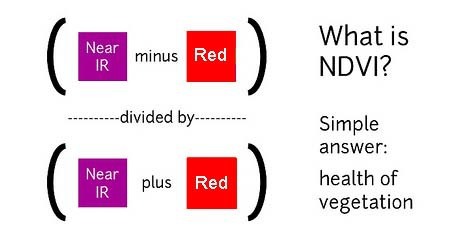](/i/44723) **NDVI = (Near Infrared - Red)/(Near Infrared + Red)** NDVI is a ratio which tries to emphasize photosynthesis while filtering out sun glare. The above equation is run for every pixel, using source data from an infrared photo and a visible light photo, like this pair: [](https://publiclab.org/system/images/photos/000/021/771/original/5390895115_c9d4d38fec_o.jpg) The result can be false-colored to make the high-photosynthesis areas more clear, and used to examine where plants are and how healthy they are. [](https://publiclab.org/system/images/photos/000/021/770/original/PetVISNDVIcomp.png) _Figure above: Normal color photo (right) and normalized difference vegetation index (NDVI) image (left). NDVI image was derived from two color channels in a single photo taken with a camera modified with a special infrared filter. Note that tree trunks, brown grass, and rocks have very low NDVI values because they are not photosynthetic. Healthy plants typically have NDVI values between 0.1 and 0.9. -- @cfastie_ ### Activities Here are a range of activities you can do to produce and interpret your own NDVI imagery, whether downloaded from a satellite imagery provider or [collected yourself using a DIY technique](/wiki/multispectral-imaging) [activities:ndvi] ****   Most DIY converted cameras today (those from Public Lab) use RGN instead of NRG, so the blue channel represents infrared instead of the red channel. That looks like this: [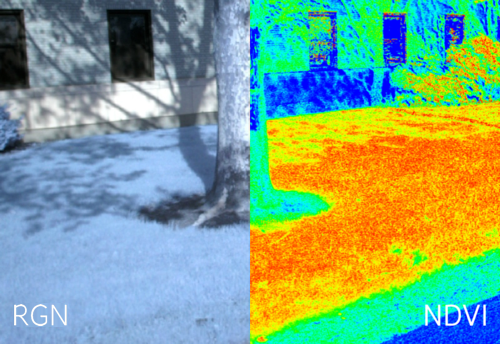](/i/45468?s=o) **** ## NRG imagery Some people are also interested in producing NRG imagery (like the below image), where `Near-Infrared, Red, and Green` are used to compose a picture instead of the usual `Red, Green, and Blue`. [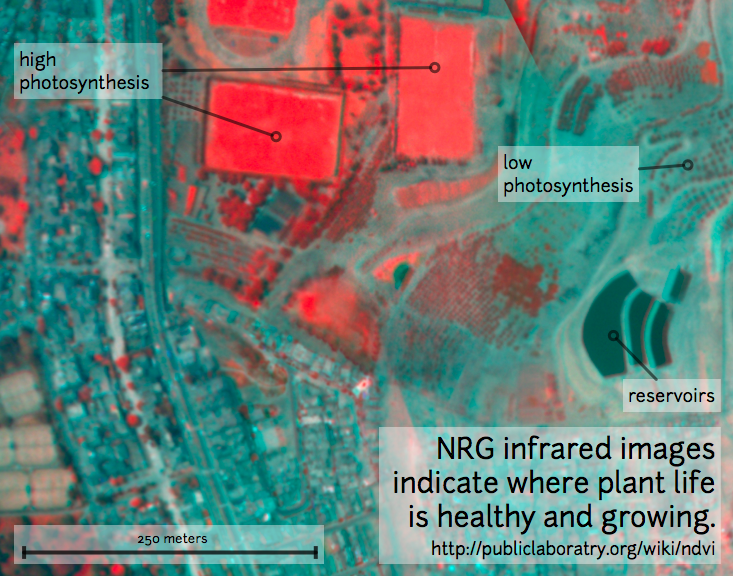](/i/25064) This diagram explains the swapping, which allows us to 'see' infrared as if it were a normal color: [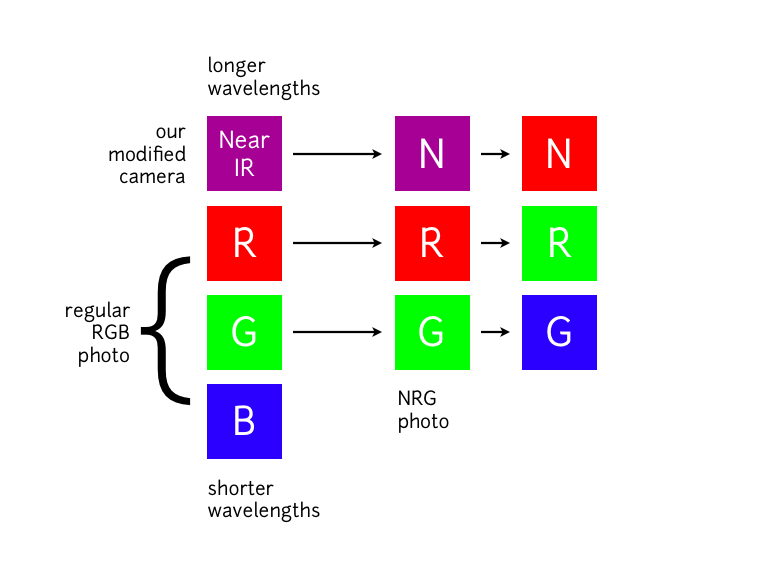](/i/25063) **In NRG images, the deeper and clearer the red color, the denser and healthier the vegetation (more or less).** ### Questions [questions:ndvi] ### Other examples of DIY NDVI imaging From around the internet: Begin watching at 2 minutes to see the resulting imagery: *This topic is part of the [Grassroots Mapping Curriculum](/wiki/mapping-curriculum) series.* **** [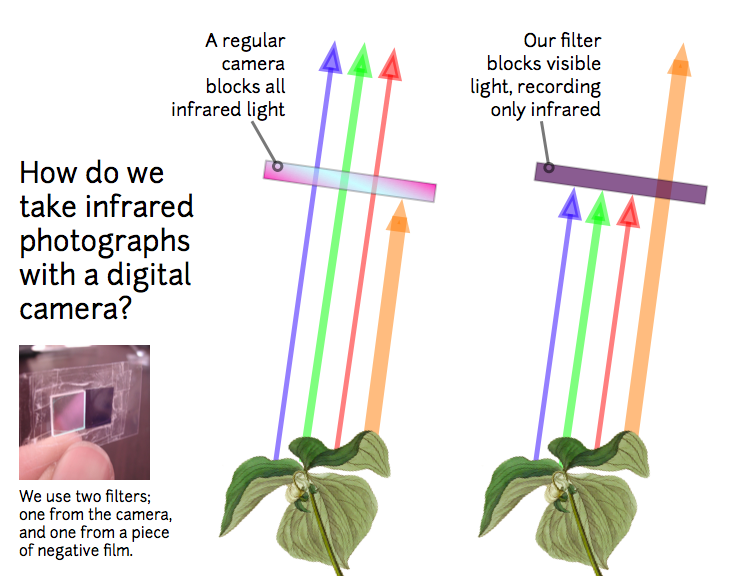](/i/25066) [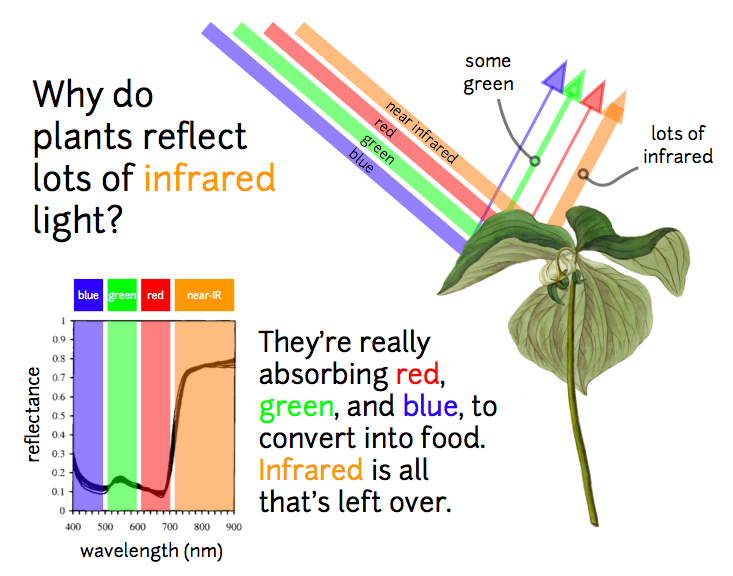](/i/25065) ...
| Author | Comment | Last activity | Moderation | ||
|---|---|---|---|---|---|
| warren | "One way to do this could involve the python version of infragram -- perhaps modded to use Infragrammar? " | Read more » | almost 10 years ago | |||
| ecta64 | "Here is a simple table that I'll start and others can fill in and modify or correct as they wish. sensor_table.doc " | | almost 10 years ago | |||
| warren | "Wow, this is pretty fascinating. I also recommend http://Infragram.org as a way to really quickly try out different composites and combinations in ..." | | almost 10 years ago | |||
| ecta64 | "I can't even begin to thank you enough for your very helpful comment! I got ImageJ and the plugins and nearly instantly the time needed to create m..." | | almost 10 years ago | |||
| cfastie | "These are really interesting results. The method in the video of computing an index is not required if you use Ned's Fiji plugin. It will compute N..." | | almost 10 years ago | |||
| ecta64 | "That I'm still working on myself. I can't find out any info on how to produce RGB only indexes with Gimp so I attempted to modify the already known..." | | almost 10 years ago | |||
| gpenzo | "What is the scale index, which color is good wich is bad?? " | | almost 10 years ago | |||
| Thorsten | "I had no problems with using lens filters so far. But it would be interesting if there is some reason to better replace the IR Filter instead. " | Read more » | almost 10 years ago | |||
| nedhorning | "I don't have experience with lens mounted filters but you might get some feedback if you post your question on the plots-infrared list at http://pu..." | Read more » | almost 10 years ago | |||
| zeigerpuppy | "What about if you added a Schott BG3 filter behind or in front of the lens, then you would have an infrablue response curve (mostly IR in the red c..." | Read more » | almost 10 years ago | |||
| zeigerpuppy | "I am thinking of getting a modified DSLR for NDVI imaging and am having trouble deciding between two different options - camera with Schott BG3 fil..." | Read more » | almost 10 years ago | |||
| cfastie | "Hi Giovanni, I posted a response at the plots-infrared Google group: https://groups.google.com/forum/#!topic/plots-infrared/l_dZKqFLGRE Chris " | Read more » | almost 10 years ago | |||
| Giovanni1983 | "Hi cfastie, I'm newbie here so I hope my comment will be soon read, even if posted on an old discussion. I also apologize in advance for all the la..." | Read more » | almost 10 years ago | |||
| nedhorning | "Hi manattta - Keep in mind that white balance and calibration are two different processes. White balance is used to adjust the in-camera processing..." | Read more » | almost 10 years ago | |||
| manattta | "Hi ned. Thank you for posting your work. I was wondering, and I just want to check, for flying a small UAV with a single NIR camera, with the cali..." | Read more » | almost 10 years ago | |||
| pswigert | "Hi! I really enjoyed this thread and seeing everyone's thoughts and responses to the question. @WhiteRabbit , I was wondering if you have any updat..." | Read more » | almost 10 years ago | |||
| cfastie | "Bob, this is a great idea. A secret admirer sent me one of these and I was very excited. I didn't know that any mortal could order them for only $3..." | Read more » | almost 10 years ago | |||
| bobmathieson | "anyone tried the Rosco sample book... only $3.95 from adorama. The swatches will not be big enough for front lens filters on SLRs but easily big en..." | Read more » | almost 10 years ago | |||
| eustatic | "this is cool. thanks, chris " | Read more » | almost 10 years ago | |||
| cfastie | "He didn't listen when they told Thomas Edison "You've tried enough filaments." He didn't listen when they told George Washington Carver "We don't n..." | Read more » | almost 10 years ago | |||
| gpenzo | "First result. Allot of work to go. " | Read more » | almost 10 years ago | |||
| warren | ";-) can't we just choose a color and stick with it, Chris? " | Read more » | almost 10 years ago | |||
| liz | "Hey @Tbtouaki , how did this turn out? " | Read more » | about 10 years ago | |||
| blkswanpres | "You can remove the ir filter on the mobius by using a heat gun to melt the glue and screwing the unit out, you can then hit it with heat again to p..." | Read more » | about 10 years ago |